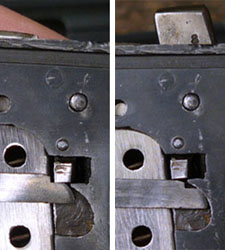 |
||||||||||||||
|
Ojanguren y Vidosa is probably better known for its revolvers than for its auto pistols, but the company made at least two auto pistols other than the Tanque. The first, under the trade name “Salvaje,” was a Ruby-type Eibar pistol with no grip safety. The second, under the trade name “Apache,” was a compact .32 caliber 1903 Browning copy with a grip safety (the “Apache” may also have been available in .25 caliber). The company made a number of different guns under the trade names “Apache,” “Tanque,” and “Crucero.” Ojanguren y Vidosa manufactured a Tanque revolver as early as 1928 (possibly earlier). The Tanque auto pistol did not appear until 1932, judging by the date stamp on the barrel, though there may be some doubt as to its authenticity. The Tanque is a hammer-fired inertially retarded
unlocked breech self loading pistol. While loosely based on Browning designs, it has some unusual features, the most obvious of which is the takedown button on the The Tanque has an unusual method of disconnecting the transfer bar that does not rely on the position of the slide on the frame like the Browning- style disconnectors. Instead, the transfer bar
itself has a rounded end which moves into a curved recess in the back of the frame. The transfer bar is forced down and out of contact with the sear by the curve of the recess. When the trigger is I was surprised that the Tanque also has an excellent magazine safety. When the magazine is inserted, a lever on the right side of the gun is pushed out to the right side, into a recess in the right grip plate, unlocking the sear. With the magazine withdrawn, a projection on the lever moves into the magazine well, the sear is locked, the hammer cannot be cocked, and if the hammer is already cocked the locked sear prevents it from being released. I can’t speak for the quality of the steel, but the workmanship on the Tanque is good. There are no burrs or sharp edges anywhere inside the gun, and I can’t detect any obvious machine marks. The frame and slide appear to be rust blued. The barrel, hammer, trigger, transfer bar, and magazine release are in the white and highly polished. The magazine is nickle plated. There are matching assembly numbers stamped on the frame, slide, barrel, hammer, and most other small parts large enough to accept them.
635 “TANQUE” PATENT The serial number is stamped on the right side of the frame, above the trigger. The serial number on my gun is poorly stamped and hard to read, but appears to be 1609. Antaris has a photographs of serial number 1995 in his book Astra Firearms and Selected Competitors, and I have seen photographs of a Tanque on the internet with a serial number in the 2000’s. Please send me the serial number of your Tanque auto pistol, and perhaps over time we can determine approximately how many were made.* There are three proof marks stamped on the barrel of my Tanque pistol. I have been unable to find the top and bottom proof marks in any reference for Spanish proofs. The top proof is upside down compared to the other two. It has some sort of figure (it looks like a bird in flight) over the letters PV. In Belgium the lion over PV is the smokeless powder proof (PV standing for “Poudre Vive”), but there is no evidence to suggest that a PV proof was ever used in Spain. The middle proof is an asterisk over the letter “E,” which in Spain is a date mark for the year 1932. The bottom proof is a figure with an OV, which must stand for Ojanguren y Vidosa. One internet source states that the Ojanguren y Vidosa firm went out of business during the Spanish civil war (1936-1939), but I have found a letter on the company letterhead dated 1941. It seems by this date the company had moved into the import-export business, and offered arms, ammunition , automobile accessories, and hardware. The letter bears the Tanque trademark. Since I originally wrote this article, I have located an identical pistol with the name “Crucero.” The slide inscription reads: 1920 MODEL AUTOMATIC PISTOL
Field Stripping
* Thus far I have been made aware of serial numbers 10, 978, 1728, 1831, 1918, 2004, 2005, 2120, 2249, and 3541. The Crucero serial number is 1173.
|
||||||||||||||
|
Copyright 2010-2017 by Ed Buffaloe. All rights reserved. |
||||||||||||||
|
|
||||||||||||||



 released, the spring-tensioned transfer bar moves forward and up, re-engaging the sear.
released, the spring-tensioned transfer bar moves forward and up, re-engaging the sear.
